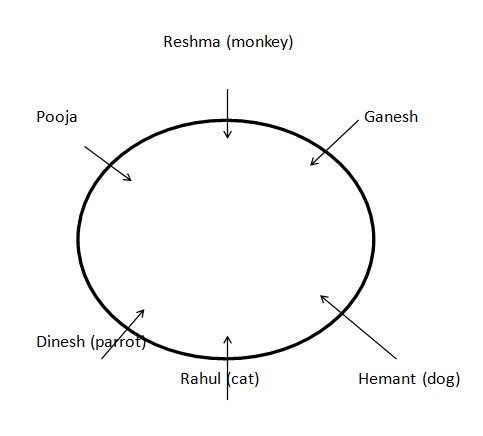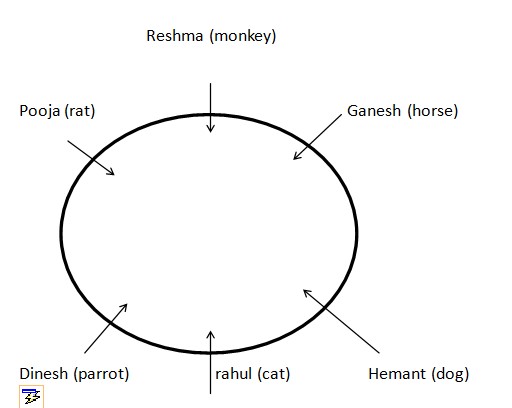Start learning 50% faster. Sign in now
From I: We have: Reshma sits second to left of Dinesh, who sits third to right of Ganesh and One who likes Dog sits immediate neighbor of Ganesh. One who likes Dog sits immediate right of Rahul who likes Cat, that means one who likes Dog sits left of Ganesh. One who likes Dog sits second to right of one who likes Parrot, that means Dinesh likes Parrot. Hemant sits second to left of one who likes Monkey, who sits immediate neighbor of Pooja, that means Hemant likes Dog. Based on above given information we get:  Since, we don’t know who likes Rat, thus result can’t be determined. Hence, statement I is not sufficient. From II: We have: Dinesh likes Parrot sits second to left of Hemant, who sits second to left of Reshma. Pooja sits second to left of Rahul, who sits immediate left of one who likes Dog and Rahul likes Cat. One who likes Monkey sits second to right of one who likes Dog, which means Reshma likes Monkey. One who likes Horse sit immediate neighbor of Hemant, that means Ganesh likes Horse. Reshma likes monkey. Based on above given information we get:
Since, we don’t know who likes Rat, thus result can’t be determined. Hence, statement I is not sufficient. From II: We have: Dinesh likes Parrot sits second to left of Hemant, who sits second to left of Reshma. Pooja sits second to left of Rahul, who sits immediate left of one who likes Dog and Rahul likes Cat. One who likes Monkey sits second to right of one who likes Dog, which means Reshma likes Monkey. One who likes Horse sit immediate neighbor of Hemant, that means Ganesh likes Horse. Reshma likes monkey. Based on above given information we get:  Thus, Dinesh sits immediate right of one who likes Rat. Hence, statement II is alone sufficient.
Thus, Dinesh sits immediate right of one who likes Rat. Hence, statement II is alone sufficient.
Rani Jhansi Marine National Park’ (RJMNP) is situated in _____________.
With reference to the standard meridian of India, consider the following statements:
1. The longitude 82º 30’E is the standard meridian of Ind...
Takla Makan desert is situated in which of the following country?
With reference to the Khejri Tree, consider the following statements:
1. It covers about two-thirds of the total geographical area of Rajasthan.<...
The standard meridian of India passes through which of the following states?
1. Jammu and Kashmir
2. Madhya Pradesh
3. Chhattisgarh...
The Nilgiri Mountain Railway connects which two towns in Tamil Nadu?
Arrange the following mountain ranges from North to South.
1. Vindhya Range
2. Ajanta range
3. Satpura range
4. Nal...
Which of the following regions are separated by Malda fault?
India shares its border with which of the following countries?
Which state is known as the "Spice Garden of India"?